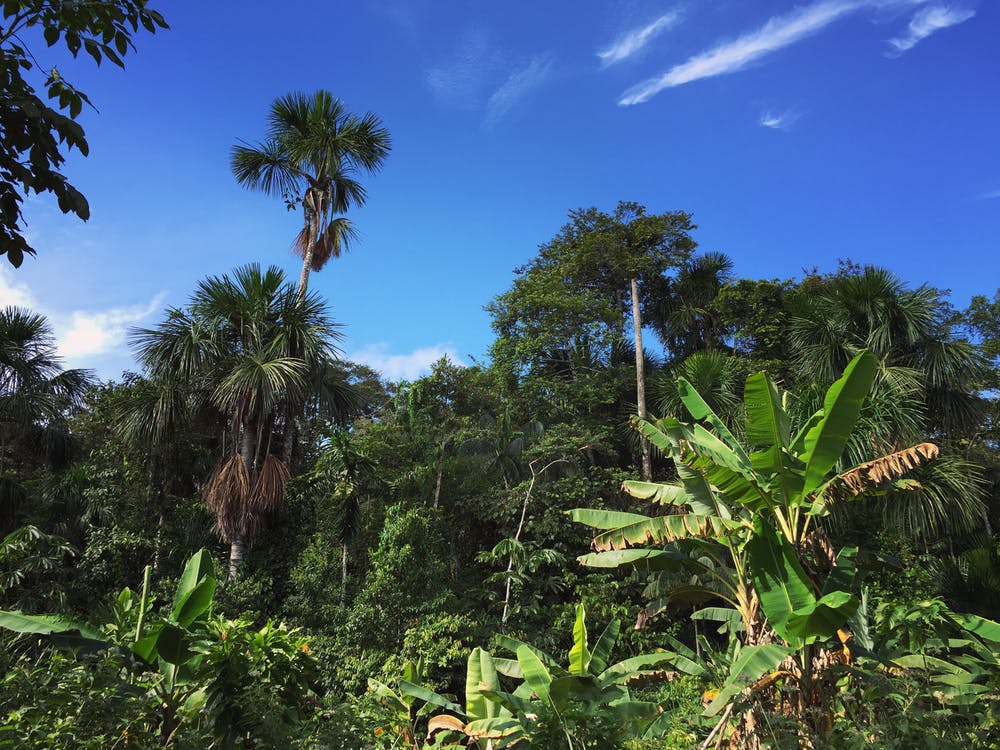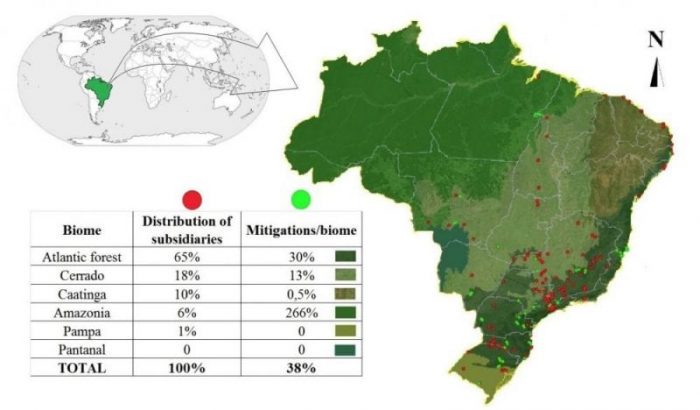
The human population obtains benefits from nature, through ecosystem services. These services are divided in (i) Provisioning services (products obtained from biomes, like water, wood, foods, etc.); (ii) Regulating services (per example, carbon sequestration and climate regulation); (iii) Cultural services (recreational, spiritual and others activities developed in nature or protected areas); and (iv) Supporting services (soil formation, nutrient recycling, primary production).
However, the unsustainable exploitation of provisioning services can generate environmental problems (environmental degradation). Thinking about this theme, we developed a project to analyze if sustainable companies, in fact, develop some conservation actions as a form to minimize (or mitigate) their own environmental impacts.
Thus, it was qualified and quantified the negative impacts on biodiversity, and, also, the minimal actions that need to be developed to mitigate (or minimize) these impacts calculated for each company. After which, the biodiversity conservation actions realized by each company were calculated. In the end, it was compared if the actions, minimally, was mitigated those impacts. Also, it was calculated how much each company needs, still, to make their own impact on biodiversity zero.
In 2050, the world population will be approximately 11 billion people. That means more people will be consuming more goods and services, pushing up the production of energy, agriculture, industry. Therefore, this will increase the exploitation of natural resources, greenhouse gas emissions, and deforestation. All this anthropization will generate problems, as forests are very important to produce water and regulate our climate. With decreasing forests, we will have an increasingly difficult problem to obtain clean water.
Obviously, different types of forests, different animals and many species, including us, humans, are part of ecosystems. All this diversity is integrated. However, if we minimize the biological diversity of forests or animals (minimizing the numbers of species and the populations) in the ecosystems, we will generate negative impacts on nature, or, biodiversity impacts.
So, the biodiversity loss plus global warming reduces the productivity of ecosystems. This, therefore, minimizes the resilience and resistance of ecosystems on climatic adversities. Many scientifical studies prove that ecosystems which have less biodiversity than other ecosystems have difficulty in restoring (regenerating) themselves.
For that, and many others reasons, biodiversity, and their ecological processes have a big influence on the global economy. Therefore, the industrial production and, also, the exploitation of natural resources, should be developed by sustainable precepts. Some companies divulge that they realize, and maintain (and support), environmental protection programs. Also, some companies have expressed interest in collaborating on biodiversity conservations.
Setting Up An Index For Sustainable Management Practices
To analyze if companies really develop minimal actions to improve the environment, we selected all companies which participated, between 2005 and 2014, on ISE (Corporate Sustainability Index – Indice de Sustentabilidade Empresarial in Portuguese) from B3 (Brazil, Bolsa, Balcão – new name of BM&FBovespa – the Brazilian Stock Exchange in Sao Paulo).
If these companies have participated since 2005, consecutively, they can be recognized as having the best sustainable management practices among other listed companies that did not enter, or do not maintain their participation in this index for a long time.
The Brazilian map below shows the location of the subsidiaries analyzed, except the financial institutions (to not crowd the image). In red, the location of each subsidiary (where it generates impact), and, in green, the biodiversity conservation action developed. All environmental data was collected from sustainability reports of 2014. All reports are in accordance with the Global Reporting Initiative – 4th generation.

Figure 1. Distribution of externalities (red points) and mitigation (greens points). (For interpretation of the references to color in this figure legend, the reader is referred to the web version of this article.) Source: Brazilian biomes – IBGE, 2004 (Adapted). Rio de Janeiro – Map scale: 1:5,000,000. Published in Journal of Cleaner Production, republished with permission from Elsevier from: https://doi.org/10.1016/j.jclepro.2017.09.123.
To developed the calculations, the LIFE certification methodology (Lasting Initiative for Earth) was used. Also, these methodologies were used as a guide to reading the almost 1,600 pages of sustainable reports used in this study for collecting environmental data.
The result shows that only one company, from paper and cellulose sector, developed sufficiently scores that minimize all their own negative impact calculated in this study. This company, also, was responsible to mitigate, alone, almost 30% of total negative impacts calculated in this study. All their subsidiaries developed impressive actions for the biodiversity conservation, since projects with environmental educational until the creation of protected areas.
On the other hand, excluding the paper and cellulose company of the results, it is possible to compare others companies. While with this company of paper and cellulose the total mitigation calculated in this study was 38%, without this company the mitigation dropped to only 9% (nine percent!). These results show that even these companies being recognized as having the best sustainable practices in the stock exchange, only one company developed sufficiently practices to minimize and mitigate the impacts on biodiversity. Consequently, only one company developed actions that save (or preserve) the ecosystem services that all companies and people use, directly or indirectly.
Therefore, if all companies developed more biodiversity conservation actions as a form to collaborate with restoring and regeneration of nature as proposed in this study, it will be possible restore the natural world, without investing much money. Saving and preserving nature is an insignificant price for the global economy.
This study, “Measurement and analyses of biodiversity conservation actions of corporations listed in the Brazilian stock exchange’s corporate sustainability index”, was recently published in the Journal of Cleaner Production, by Ricardo Reale and Teresa Cristina Magro, from Natural Protected Areas Laboratory (LANP), Department of Forest Sciences, Escola Superior de Agricultura “Luiz de Queiroz” (ESALQ), Universidade de São Paulo (USP), and Luiz César Ribas, from Department of Economy, Sociology e Technology, Faculdade de Ciências Agronômicas (FCA), Universidade Estadual Paulista “Júlio de Mesquita Filho” (UNESP), Brazil.









